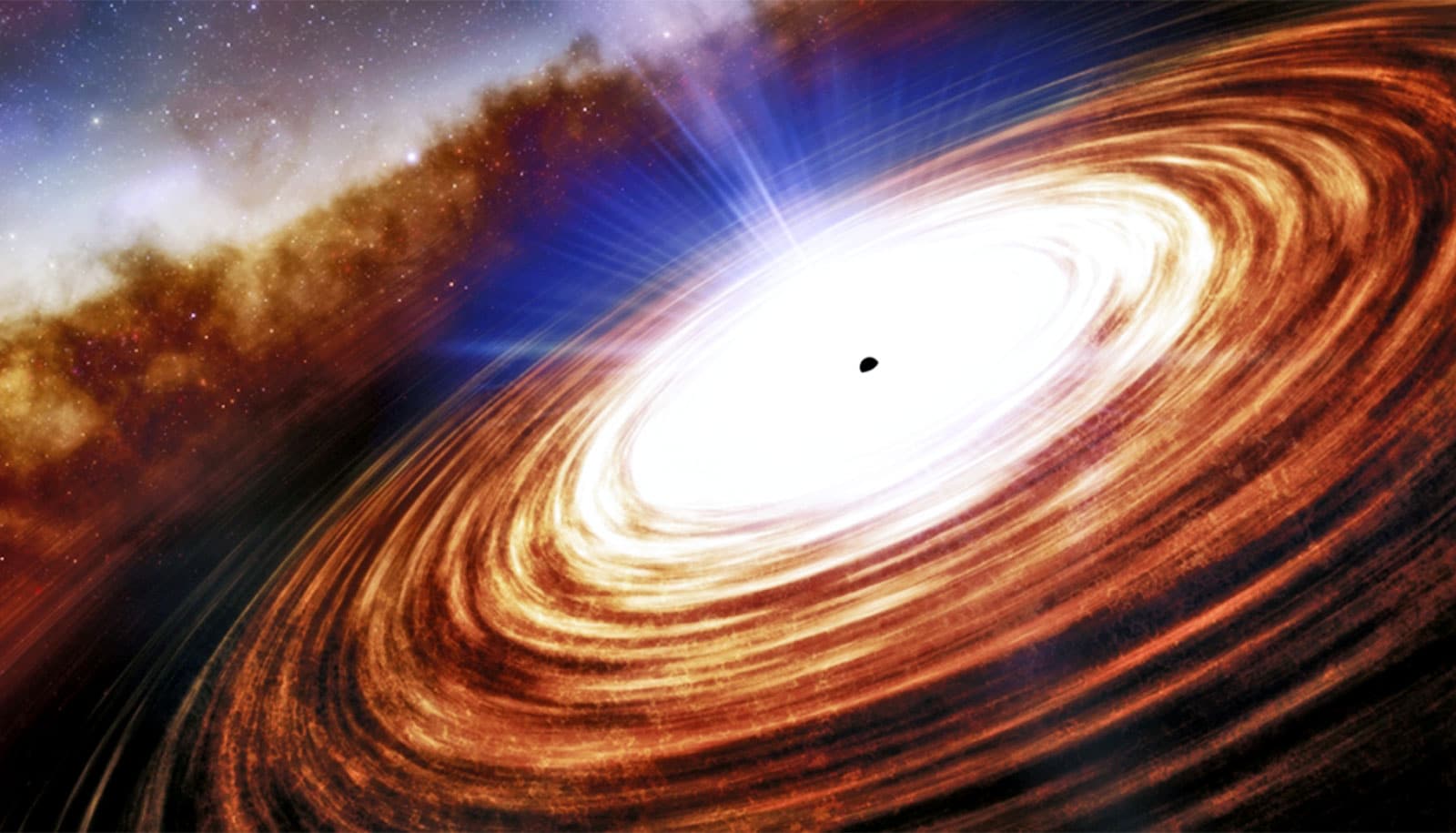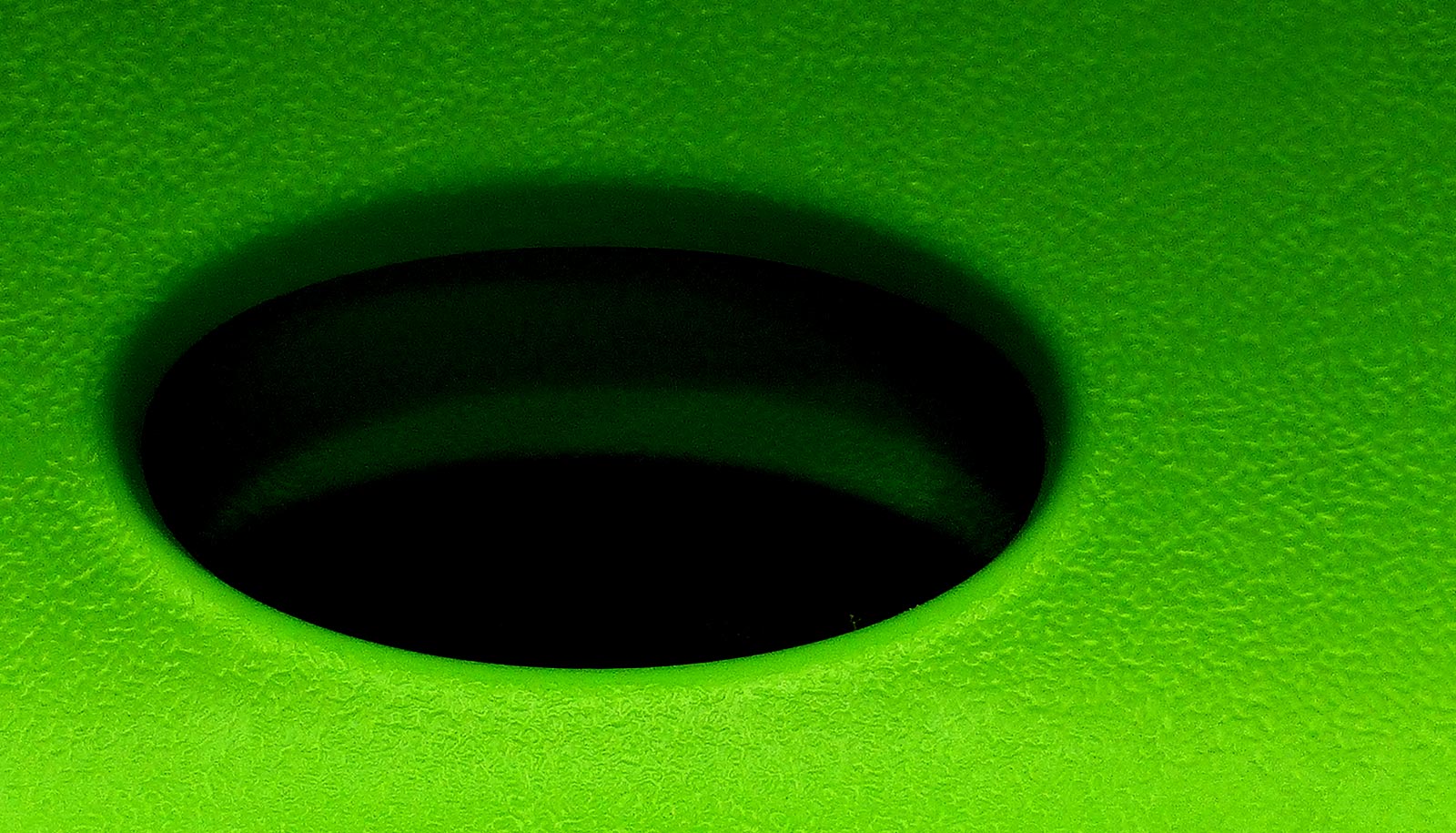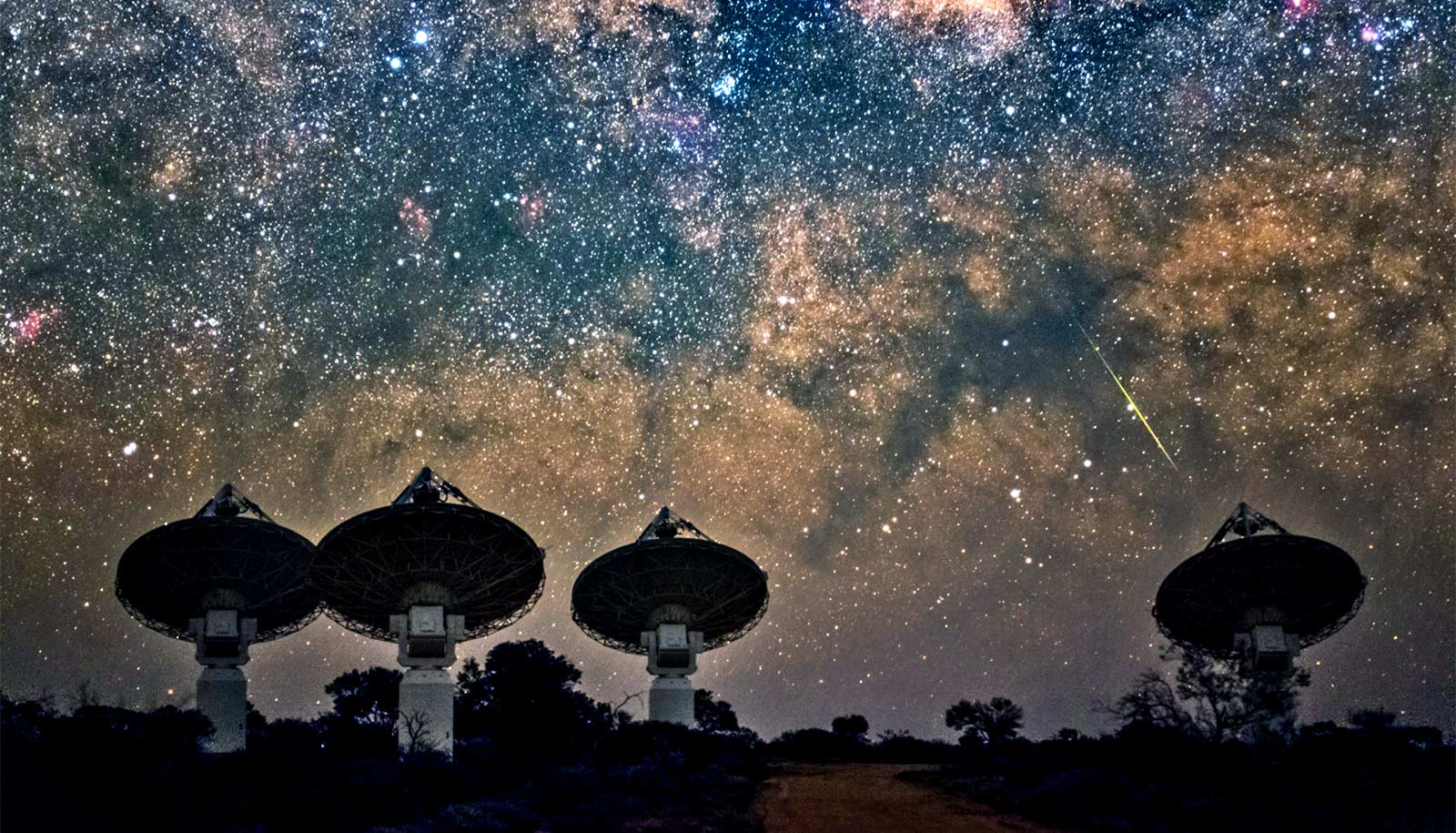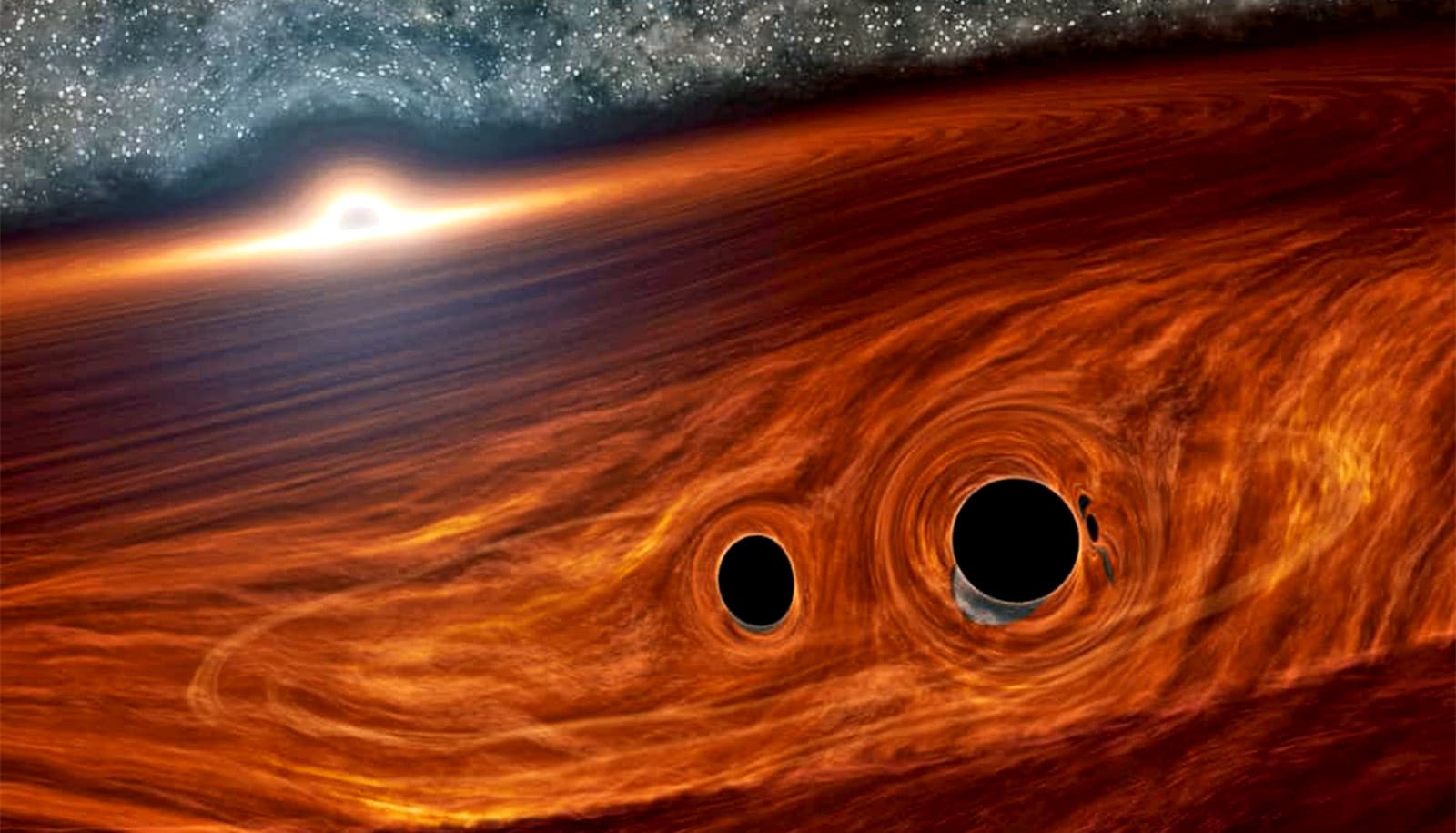Astronomers have observed a luminous quasar 13.03 billion light-years from Earth—the most distant quasar discovered to date.
Dating back to 670 million years after the Big Bang, when the universe was only 5% its current age, the quasar hosts a supermassive black hole equivalent to the combined mass of 1.6 billion suns.
In addition to being the most distant—and by extension, earliest—quasar known, the object is the first of its kind to show evidence of an outflowing wind of super-heated gas escaping from the surroundings of the black hole at a fifth of the speed of light.
In addition to revealing a strong quasar-driven wind, the new observations also show intense star formation activity in the host galaxy where the quasar, formally designated J0313-1806, is located.
Researchers discovered the previous record-holder among quasars in the infant universe three years ago.
Quasars are thought to result from supermassive black holes gobbling up surrounding matter, such as gas or even entire stars, resulting in a maelstrom of superheated matter known as an accretion disk that swirls around the black hole. Because of the enormous energies involved, quasars are among the brightest sources in the cosmos, often outshining their host galaxies.
Although J0313-1806 is only 20 million light-years farther away than the previous record holder, the new quasar contains a supermassive black hole twice as heavy. This marks a significant advancement for cosmology, as it provides the strongest constraint yet on the formation of black holes in the early universe.
“This is the earliest evidence of how a supermassive black hole is affecting its host galaxy around it,” says lead author Feige Wang, a Hubble Fellow at the University of Arizona’s Steward Observatory. “From observations of less distant galaxies, we know that this has to happen, but we have never seen it happening so early in the universe.”
Quasars that already amassed millions, if not billions, of solar masses in their black holes at a time when the universe was very young pose a challenge to scientists trying to explain how they came into existence when they barely had the time to do so.
A commonly accepted explanation of black hole formation involves a star exploding up as a supernova at the end of its life and collapsing into a black hole. When such black holes merge over time, they can—theoretically—grow into supermassive black holes.
However, much like it would require many lifetimes to build a retirement fund by chipping in a dollar each year, quasars in the early universe are a little bit like toddler millionaires; they must have acquired their mass by other means.
How did distant quasar’s black hole form?
The newly discovered quasar provides a new benchmark by ruling out two current models of how supermassive black holes form in such short timescales. In the first model, massive stars that consist largely of hydrogen and lack most other elements that make up later stars, including metals, form the first generation of stars in a young galaxy and provide the food for the nascent black hole. The second model involves dense star clusters, which collapse into a massive black hole right from the outset.
Quasar J0313-1806, however, boasts a black hole too massive to be explained by those scenarios, according to the researchers who discovered it. The team calculated that if the black hole at its center formed as early as 100 million years after the Big Bang and grew as fast as possible, it still would have had to have at least 10,000 solar masses to begin with.
“This tells you that no matter what you do, the seed of this black hole must have formed by a different mechanism,” says coauthor Xiaohui Fan, professor and associate head of the astronomy department. “In this case, one that involves vast quantities of primordial, cold hydrogen gas directly collapsing into a seed black hole.”
Because this mechanism doesn’t require full-fledged stars as raw material, it is the only one that would allow the supermassive black hole of quasar J0313-1806 to grow to 1.6 billion solar masses at such an early time in the universe. This is what makes the new record quasar so valuable, Fan says.
“Once you go to lower redshifts, all the models could explain the existence of those less distant and less massive quasars,” Fan says. Redshift refers to the phenomenon in which light from far-away objects appears redder than light from closer sources because of the ongoing expansion of the universe.
“In order for the black hole to have grown to the size we see with J0313-1806, it would have to have started out with a seed black hole of at least 10,000 solar masses, and that would only be possible in the direct collapse scenario,” Fan says.
Quasar’s host galaxy growing fast
The newly discovered quasar appears to offer a rare glimpse into the life of a galaxy at the dawn of the universe when many of the galaxy-shaping processes that have since slowed or ceased in galaxies that have been around for much longer were still in full swing.
According to current models of galaxy evolution, supermassive black holes growing at their centers could be the main reason why galaxies ultimately stop making new stars. Acting like a blowtorch of cosmic proportions, quasars blast their surroundings fiercely, effectively sweeping their host galaxy clean of much of the cold gas that serves as the raw material from which stars form.
“We think those supermassive black holes were the reason why many of the big galaxies stopped forming stars at some point,” Fan says. “We observe this ‘quenching’ at lower redshifts, but until now, we didn’t know how early this process began in the history of the universe. This quasar is the earliest evidence that quenching may have been happening at very early times.”
Wang’s team measured the quasar’s luminosity and calculated that the supermassive black hole at its center is ingesting the mass equivalent of 25 suns each year, on average, which is thought to be the main reason for its high-velocity hot plasma wind blowing into the galaxy around it at relativistic speed. For comparison, the black hole at the center of the Milky Way has become mostly dormant.
And while the Milky Way forms stars at the leisurely pace of about one solar mass each year, J0313-1806 churns out 200 solar masses in the same time period.
“This is a relatively high star formation rate, similar to that observed in other quasars of similar age, and it tells us the host galaxy is growing very fast,” Wang says.
“These quasars presumably are still in the process of building their supermassive black holes” Fan says. “Over time, the quasar’s outflow heats and pushes all the gas out of the galaxy, and then the black hole has nothing left to eat anymore and will stop growing. This is evidence about how these earliest massive galaxies and their quasars grow.”
The researchers expect to find a few more quasars from the same time period, including potential new record breakers, says Jinyi Yang, the second author of the report and a fellow at the Steward Observatory. Yang and Fan were observing at the 6.5-meter Magellan Baade telescope at the Las Campanas Observatory in Chile the night J0313-1806 was discovered.
“Our quasar survey covers a very wide field, allowing us to scan almost half of the sky,” Yang says. “We have selected more candidates on which we will follow up with more detailed observations.”
Looking ahead
The researchers hope to uncover more about the quasar’s secrets with future observations, especially with NASA’s James Webb Space Telescope, currently slated for launch in 2021.
“With ground-based telescopes, we can only see a point source,” Wang says. “Future observations could make it possible to resolve the quasar in more detail, show the structure of its outflow, and how far the wind extends into its galaxy, and that would give us a much better idea of its evolutionary stage.”
In addition to the 6.5-meter Magellan Baade telescope, researchers used the following instruments in this study: The Gemini North Telescope and the W. M. Keck Observatory—both on Maunakea, Hawaii—and the Gemini South Telescope, Víctor M. Blanco 4-meter Telescope at Cerro Tololo Inter-American Observatory, and ALMA, the Atacama Large Millimeter Array, all located in Chile’s Atacama Desert.
Data from the Blanco Telescope, taken as part of the DESI Legacy Imaging Surveys, helped to first identify J0313-1806, while Gemini South observations were used to confirm its identity as a quasar.
Researchers presented their findings, which they submitted for publication in Astrophysical Journal Letters, during a press conference and a scientific talk at the virtual 237th Meeting of the American Astronomical Society.
The research team also includes astronomer Richard Green and doctoral student Minghao Yue, both at Steward Observatory. NASA, the National Science Foundation, the European Research Council, and the National Science Foundation of China funded the work.
The Magellan Telescopes are managed by a collaboration of universities from the United States including the University of Arizona. NSF’s National Optical-Infrared Astronomy Research Laboratory, or NOIRLab operates the Gemini Observatory and Cerro Tololo Inter-American Observatory.
The astronomical community is honored to have the opportunity to conduct astronomical research on Iolkam Du’ag (Kitt Peak) in Arizona, on Maunakea in Hawaii, and on Cerro Tololo and Cerro Pachón in Chile. We recognize and acknowledge the very significant cultural role and reverence that these sites have to the Tohono O’odham Nation, to the Native Hawaiian community and to the local communities in Chile, respectively.
Source: University of Arizona
“This is the earliest evidence of how a supermassive black hole is affecting its host galaxy around it,” says Feige Wang. “From observations of less distant galaxies, we know that this has to happen, but we have never seen it happening so early in the universe.”



